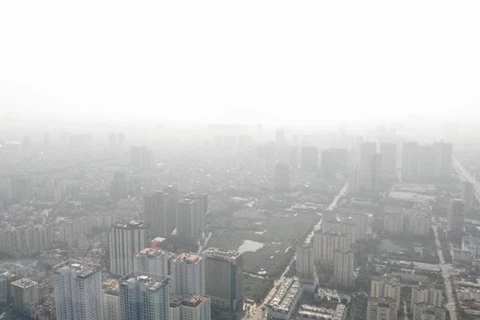HCM City (VNS/VNA) - Several southern cities and provinces have accelerated research into air pollution to develop clean air plans by 2025, according to Assoc. Prof. Dr Ho Quoc Bang from the Institute for Environment and Resources at the Vietnam National University - HCM City.
HCM City, Can Tho, and several provinces have studied emissions inventories, calculating the impact of air pollution on human health, as well as emissions zoning and air quality modelling, to better manage the local air environment, he said.
An emissions inventory released by Can Tho City last year revealed that 50 percent of local dust emissions came from cement, brick, and paper production, and 30 percent from the burning of straw. Motorcycles were responsible for 46 percent of the emission of non-methane volatile organic compounds (VMVOCs), while 29 percent came from the textile-garment industry. Carbon monoxide (CO) emissions were mainly produced by motorbikes and straw burning.
Densely-populated HCM City, meanwhile, is in a similar situation, with 37.7 percent of dust emissions originating from motorbikes and other vehicles and 11.4 percent from households.
To assess the impact of air pollution on human health, scientists have developed scenarios on the number of deaths from lung cancer after exposure to fine dust (PM2.5) and air pollutants and integrated them into renewable energy development policies. Air pollution causes an estimated 8.8 million deaths worldwide each year.
Through such studies, solutions and actions have been proposed to help Can Tho improve its air quality. The city has been advised to better control and reduce emissions from vehicles by setting up working groups on vehicle inspections and requiring emissions testing on all motorbikes.
Other measures include expanding public transport networks and sustainably developing urban transport, with improved pedestrian infrastructure and a trial bicycle sharing system, installing and evaluating air quality monitoring technology at factories, and identifying technological solutions for reducing emissions from textile, paper, and metalworking plants.
Bang called for greater cooperation for the studies to reach more southern cities and provinces and elsewhere. Policymakers also need to issue guidelines for localities on formulating and implementing clean air plans, a set of indexes measuring emissions from industry and transport, and a guidebook on emissions inventories in Vietnam, he added./.
HCM City, Can Tho, and several provinces have studied emissions inventories, calculating the impact of air pollution on human health, as well as emissions zoning and air quality modelling, to better manage the local air environment, he said.
An emissions inventory released by Can Tho City last year revealed that 50 percent of local dust emissions came from cement, brick, and paper production, and 30 percent from the burning of straw. Motorcycles were responsible for 46 percent of the emission of non-methane volatile organic compounds (VMVOCs), while 29 percent came from the textile-garment industry. Carbon monoxide (CO) emissions were mainly produced by motorbikes and straw burning.
Densely-populated HCM City, meanwhile, is in a similar situation, with 37.7 percent of dust emissions originating from motorbikes and other vehicles and 11.4 percent from households.
To assess the impact of air pollution on human health, scientists have developed scenarios on the number of deaths from lung cancer after exposure to fine dust (PM2.5) and air pollutants and integrated them into renewable energy development policies. Air pollution causes an estimated 8.8 million deaths worldwide each year.
Through such studies, solutions and actions have been proposed to help Can Tho improve its air quality. The city has been advised to better control and reduce emissions from vehicles by setting up working groups on vehicle inspections and requiring emissions testing on all motorbikes.
Other measures include expanding public transport networks and sustainably developing urban transport, with improved pedestrian infrastructure and a trial bicycle sharing system, installing and evaluating air quality monitoring technology at factories, and identifying technological solutions for reducing emissions from textile, paper, and metalworking plants.
Bang called for greater cooperation for the studies to reach more southern cities and provinces and elsewhere. Policymakers also need to issue guidelines for localities on formulating and implementing clean air plans, a set of indexes measuring emissions from industry and transport, and a guidebook on emissions inventories in Vietnam, he added./.
VNA






















